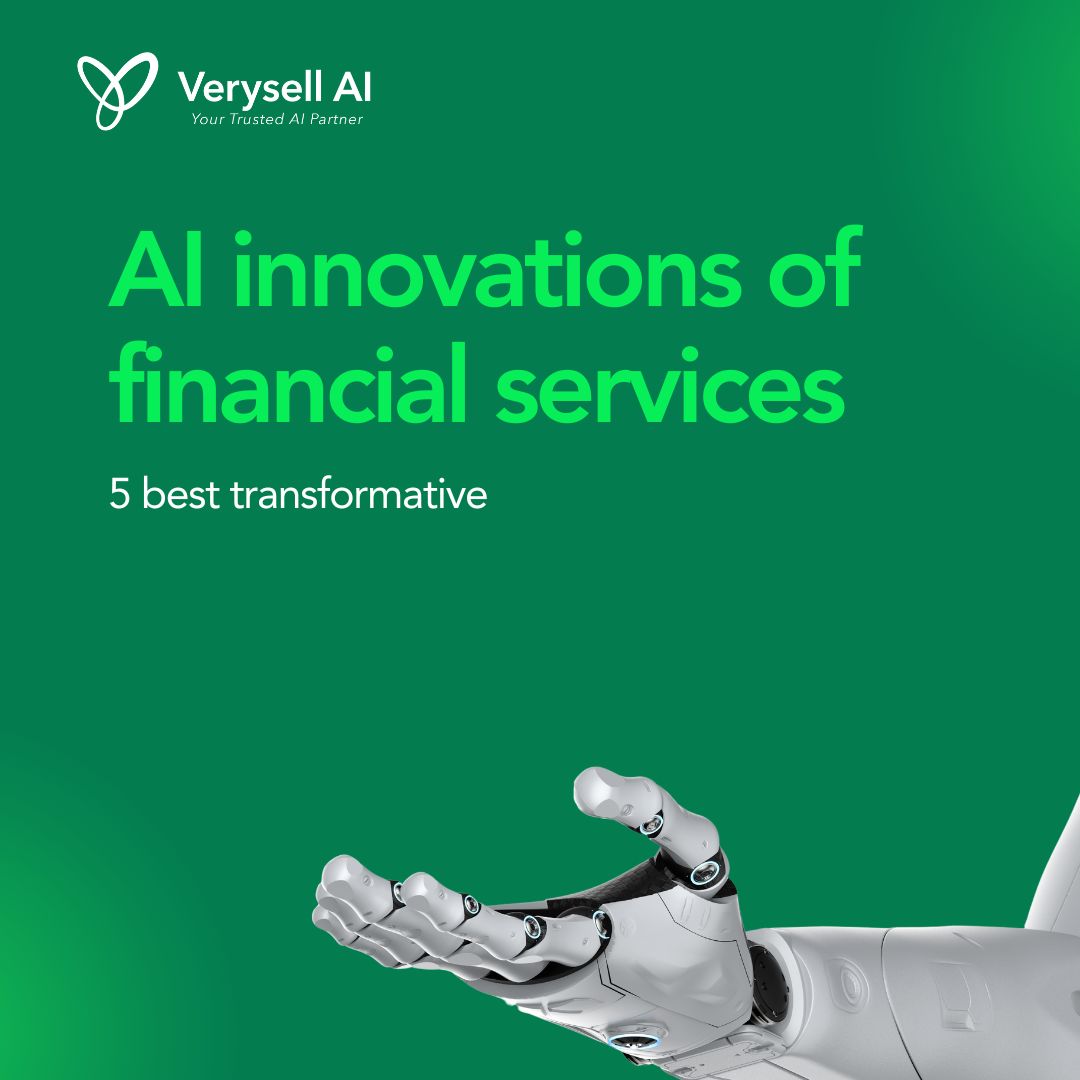AI innovations, which are revolutionizing how financial institutions operate, interact with customers, and manage risks. These advancements are not only enhancing operational efficiency but also enabling customer experiences (Swamy, 2025). As financial institutions seek to remain competitive in a rapidly evolving landscape, leveraging AI has become essential. In this blog post, we will explore five transformative AI innovations that are shaping the future of financial services.

AI Innovations of Financial Services
Institutions are leveraging machine learning algorithms to automate routine tasks, such as data entry and transaction processing, which reduces human error and speeds up workflows. Additionally, AI-driven analytics provide insights into customer behavior, enabling firms to tailor products and services to meet individual needs, ultimately improving customer satisfaction and loyalty.
>> Click here to explore our webinar about agentic AI for BFSI enterprises
1. Enhanced Customer Experiences through Chatbots
AI-powered chatbots not only enhance efficiency but also ensure consistent service delivery by handling high volumes of inquiries without human intervention. They can seamlessly integrate with various communication channels, including mobile apps, websites, and social media platforms, providing customers with easy access to support. This constant availability builds customer trust and satisfaction, as users can get timely responses, whether it’s for troubleshooting, information requests, or completing transactions.
>> Explore more about VERA – feature AI customer support operations from Verysell AI
There are top 2 benefits that any enterprises should be considered that instant support and personalisation chatbot. Firstly, chatbots equipped with advanced Natural Language Processing (NLP) capabilities can respond to a wide array of customer inquiries at any time, ensuring immediate assistance. For instance, a customer needing quick information about their account balance or transaction history can receive an instant response without having to navigate through long menus or wait in a queue.

Secondly, by leveraging AI and machine learning algorithms, chatbots can continuously analyze past interactions, customer preferences, and behavioral data. This allows chatbots to adapt their responses and proactively offer tailored services based on individual customer needs. For example, if a customer frequently inquires about loan options, the chatbot can suggest relevant products or provide reminders about application deadlines, enhancing the customer’s overall engagement with the bank.
You can also deeply understand our case study with clients by clicking here.
2. Fraud Detection and Prevention
Fraud remains one of the most significant threats in the financial services industry, costing businesses billions annually (Telesign Team, 2024). Traditional methods often rely on predefined rules, which can miss new, sophisticated fraud tactics. AI, however, provides a more dynamic and intelligent approach by analyzing vast datasets to detect anomalies and irregularities. By leveraging machine learning, AI systems can recognize patterns within transactions that deviate from typical behavior, helping to flag suspicious activities before they lead to major losses. This ability to identify potential fraud in real-time provides financial institutions with the agility to respond faster and more effectively to prevent further damage.
>> Read more about fraud detection and prevention in the BFSI market

AI fraud detection systems rely heavily on machine learning models, which are trained using historical transaction data to identify patterns that indicate fraudulent activity. These models continuously improve their accuracy by learning from new data, enabling them to detect even the most subtle and evolving fraudulent behaviors. Additionally, behavioural analysis plays a critical role in monitoring user behavior to identify deviations that might suggest unauthorized actions, such as unusual spending patterns or logins from unfamiliar locations. These systems build individual user profiles based on historical activity, making it easier to flag any behavior that doesn’t align with typical patterns. By combining these approaches, AI-driven systems can offer a highly effective, adaptive, and proactive solution to fraud prevention.
One prominent example comes from a major credit card company that saw a 30% decrease in fraudulent transactions after implementing AI-based detection tools. This improvement was attributed to the system’s ability to analyze transactions more thoroughly and detect fraudulent behavior at earlier stages. As AI continues to evolve, its ability to prevent fraud will likely become even more sophisticated, helping financial institutions stay ahead of fraudsters.
3. Risk Management and Compliance
AI enhances risk management by analyzing vast amounts of data to uncover patterns and trends that may not be immediately obvious to human analysts (Metricstream, 2025). With the ability to process real-time market information and customer behaviors, AI helps financial institutions anticipate potential risks, such as market volatility or credit defaults, and adjust strategies accordingly. This predictive capability enables firms to make more informed decisions, reduce uncertainty, and ensure compliance with evolving regulatory requirements.

AI can analyze historical data to predict potential market risks, enabling financial institutions to adjust their strategies proactively. This helps mitigate financial exposure by identifying risks like market volatility or credit defaults before they impact the business. Moreover, AI tools automate the process of compliance checks, ensuring financial institutions adhere to evolving regulations with greater accuracy. By reducing human error, these systems streamline compliance efforts and help avoid penalties while improving operational efficiency.
4. Algorithmic Trading
AI-driven algorithmic trading is transforming how trades are executed in the financial markets. Algorithms analyze market data at lightning speed, making trades based on pre-set criteria. These AI algorithms can process vast amounts of data in real-time, identifying patterns and opportunities that human traders might miss, leading to faster and more informed decision-making.

AI-driven algorithmic trading offers significant advantages, including unmatched speed and efficiency, allowing trades to be executed in milliseconds and capitalizing on market opportunities that human traders might miss. Additionally, these algorithms process vast amounts of data-driven decisions, ensuring that trades are based on thorough analysis rather than relying on intuition. As a result, financial institutions can achieve more accurate, timely, and profitable trading outcomes. For instance, a hedge fund that implemented AI-based trading strategies saw by an average of 12%, highlighting the effectiveness of these advanced technologies in optimizing trading performance (Clarigro, 2024).
5. Personalised Financial Services
AI is transforming how financial institutions offer products and services by enabling them to personalize their offerings based on individual customer needs. Through data analysis, AI can gather insights from vast amounts of customer data, including spending habits, preferences, and transaction history, allowing financial institutions to create highly personalized recommendations. This level of customization helps build stronger relationships with customers, as the services provided align more closely with their specific requirements, making their financial journeys more relevant and efficient.

In addition, dynamic pricing powered by AI allows financial institutions to adjust pricing models based on individual customer profiles (Takyar, 2024). This ensures that pricing remains competitive and tailored, providing customers with a more personalised customer experiences. A successful example of this is a fintech startup that leveraged AI to develop personalized investment portfolios, which led to a 50% increase in customer acquisition (Coherent Solutions, 2025). This illustrates how AI can not only enhance customer satisfaction but also drive significant business growth by offering customized financial solutions that meet the unique needs of each client.
Conclusion
The integration of AI into financial services is not just a trend; it is a fundamental shift that is enhancing efficiency, improving customer experiences, and driving innovation in the BFSI sector. As these technologies continue to evolve, financial institutions that embrace AI will be better positioned to navigate the complexities of the market and meet the changing needs of their customers. The future of finance is here, and it is powered by AI. By leveraging these innovations, banks and financial service providers can not only stay competitive but also thrive in an increasingly digital landscape. Are you ready to explore with us, contact us to know more about our services and solutions.


